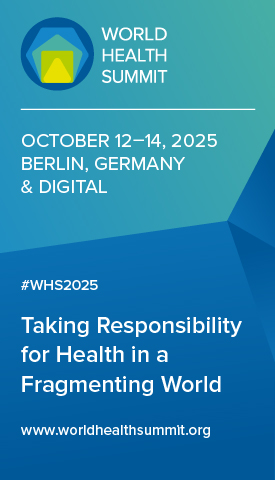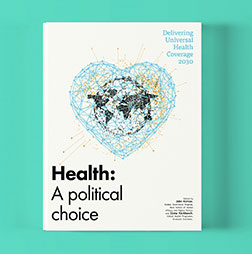The equity bias in cardiovascular care we can’t ignore
This article was funded and written by Daiichi Sankyo Europe Document number UK/DSC/09/25/0005 and MED-EU-NON-00132 Date of preparation September 2025
In the WHO European Region, CVD causes 37% of deaths among women and 31% among men,2 contributing to 17.9 million deaths annually worldwide.1 Despite being the leading cause of death for women globally – accounting for 30% of deaths3 – CVD continues to be perceived primarily as a men’s disease.4 This misperception leads to women being understudied, underdiagnosed and undertreated.5
Disparities in Cardiovascular Care
Women may experience different CV symptoms than men. Our recent survey on public perception on cardiovascular care including over 8,500 Europeans revealed that over 50% of patients are not aware of gender differences in cardiovascular symptoms. However, two out of three male patients say they have been offered specific advice or support to talk about their risk of cardiovascular disease due to their age/health status, compared to only half of female patients.6 What is more, compared to men, women are more vulnerable to the indirect effects of socioeconomic challenges and political conflicts which could contribute to increased CVD risk.7
Historical underrepresentation of women in cardiovascular clinical trials has created significant gaps in understanding how CVD uniquely affects women.8 Medical education perpetuates these disparities by standardising risk factors to male patterns, overlooking women-specific risk factors such as menopause or pregnancy complications.9
The gap extends beyond patients to the cardiology profession itself. Women represent only 20% of cardiologists globally and hold less than 10% of leadership positions.10 The negative effect might even extend to patient outcomes – research from a US study suggests that following a CVD event, women may fare better when treated by female doctors.11
Innovation and Collaboration for Change
At Daiichi Sankyo Europe, we are keenly aware of the challenges women face in in the CV landscape and are committed to focused attention and strategic, multi-stakeholder collaboration to drive meaningful change.
Our recent research efforts have shown that over half of the respondents believe partnerships between pharmaceutical companies and doctors are needed for disease awareness and preventing misinformation.12 Indeed, we are partnering with Women as One10 to support female leaders in cardiology and provide professional opportunities to women cardiologists in scientific activities and clinical trials.13 We are also backing Global Heart Hub’s patient-driven research on CVD in women.14
A Vision for the Future
As the World Health Summit explores closing the gender health gap, we advocate for comprehensive national heart health plans. We support the European Alliance for Cardiovascular Health’s pioneering work to incorporate gender-specific targets into EU-wide cardiovascular strategies and call for an EU Cardiovascular Health Plan addressing gender disparity.15
Our aspiration is that scientific innovation fully values women as patients, healthcare providers and essential research participants, advancing cardiovascular medicine to really care for every heart.
References:
1 World Health Organization, Cardiovascular diseases (CVDs). Available at: https://www.who.int/news-room/fact-sheets/detail/cardiovascular-diseases-(cvds). Last accessed Aug. 2025
2 European Society of Cardiology EU27 Cardiovascular Realities 2025. Available at: https://www.flipsnack.com/escardio/eu-27-cardiovascular-realities-2025/full-view.html. Last accessed Aug. 2025
3 World Heart Federation, CVD & Women Infographic. Available at: https://world-heart-federation.org/resource/cvd-women-infographic/. Last accessed Aug. 2025
4 Alshakarah A, et al. Awareness and Knowledge of Cardiovascular Diseases and Its Risk Factors Among Women of Reproductive Age: A Scoping Review. Cureus. 2023 Dec 2;15(12):e49839. doi: 10.7759/cureus.49839. PMID: 38164316; PMCID: PMC10758256.
5 The Lancet, Volume 397. The Lancet women and cardiovascular disease Commission: reducing the global burden by 2030. Vogel, Birgit et al., Issue 10292, 2385 – 2438
6 Daiichi Sankyo Europe CVD. A European Heart Health Survey: Public Perceptions on Cardiovascular Care. May 2025. Responses gathered from multiple choice survey across Austria, Belgium, Germany, Italy, Portugal, Spain from 3,674 patients and 4,906 members of the public. Available at: https://wecareforeveryheartbeat.com/wp-content/uploads/2025/07/Factsheet_Public_Perceptions_on_CV_Care_Health_Care_Professionals.pdf. Last accessed Aug. 2025
7 Vogel et al., The Lancet women and cardiovascular disease Commission.
8 Jin X, Chandramouli C, Allocco B, Gong E, Lam CSP, Yan LL. Women’s Participation in Cardiovascular Clinical Trials From 2010 to 2017. Circulation. 2020 Feb 18;141(7):540-548. Available at https://doi.org/10.1161/CIRCULATIONAHA.119.043594. Last accessed Aug. 2025
9 Suman S, Pravalika J, Manjula P, Farooq U. Gender and CVD- Does It Really Matters? Curr Probl Cardiol. 2023 May;48(5):101604. Available at: https://doi.org/10.1016/j.cpcardiol.2023.101604. Last accessed Aug. 2025
10 Women as One. https://womenasone.org/. Last accessed Aug. 2025.
11 Greenwood BN, Carnahan S, Huang L. Patient-physician gender concordance and increased mortality among female heart attack patients. Proc Natl Acad Sci U S A. 2018 Aug 21;115(34):8569-8574. doi: 10.1073/pnas.1800097115. Epub 2018 Aug 6. PMID: 30082406; PMCID: PMC6112736. Last accessed Aug. 2025
12 Daiichi Sankyo Europe CVD. Available at: https://wecareforeveryheartbeat.com/wp-content/uploads/2025/07/Factsheet_Public_Perceptions_on_CV_Care_General_Audience.pdf. Last accessed Aug. 2025
13 Daiichi Sankyo Europe. Investing in Women’s Hearts. Available at: https://wecareforeveryheartbeat.com/campaign-investing-in-womens-hearts/. Last accessed Aug. 2025
14 Global Heart Hub. Patient Driven research on CVD in Women, 2024. Available at: Women and Heart Report – Global Heart Hub. Last accessed Aug 2025
15 European Alliance for Cardiovascular Health. EACH Cardiovascular Health Plan for Europe. 13 May 2022. Available at: https://www.cardiovascular-alliance.eu/wp-content/uploads/2022/05/EACH-Plan-Final_130522.pdf. Last accessed Aug. 2025












